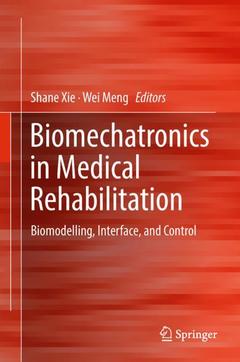Description
Biomechatronics in Medical Rehabilitation, Softcover reprint of the original 1st ed. 2017
Biomodelling, Interface, and Control
Language: English
Subjects for Biomechatronics in Medical Rehabilitation:
Biomechatronics in Medical Rehabilitation
Publication date: 02-2017
Support: Print on demand
Publication date: 02-2017
Support: Print on demand
Biomechatronics in Medical Rehabilitation
Publication date: 07-2018
Support: Print on demand
Publication date: 07-2018
Support: Print on demand
Description
/li>Contents
/li>Biography
/li>Comment
/li>
This book focuses on the key technologies in developing biomechatronic systems for medical rehabilitation purposes. It includes a detailed analysis of biosignal processing, biomechanics modelling, neural and muscular interfaces, artificial actuators, robot-assisted training, clinical setup/implementation and rehabilitation robot control.
Encompassing highly multidisciplinary themes in the engineering and medical fields, it presents researchers? insights into the emerging technologies and developments that are being utilized in biomechatronics for medical purposes.
Presenting a detailed analysis of five key areas in rehabilitation robotics: (i) biosignal processing; (ii) biomechanics modelling; (iii) neural and muscular interfaces; (iv) artificial actuators and devices; and (v) the use of neurological and muscular interfaces in rehabilitation robots control, the book describes the design of biomechatronic systems, the methods and control systems used and the implementation and testing in order to show how they fulfil the needs of that specific area of rehabilitation. Providing a comprehensive overview of the background of biomechatronics and details of new advances in the field, it is especially useful for researchers, academics and graduates new to the field of biomechatronics engineering, and is also of interest to researchers and clinicians in the medical field who are not engineers.
Introduction.- State of the Art.- Signal Processing Methods for SSVEP-based BCIs.- SSVEP-Based BCI for Lower Limb Rehabilitation.- A Hybrid BCI for Gaming.- EMG-Driven Physiological Model for Upper Limb.- Exoskeleton Control Based on Neural Interface.- Muscle Force Estimation Model for Gait Rehabilitation.- Neuromuscular Model for Gait Rehabilitation.- Conclusions and Future Prospects
At the University of Auckland we have 15 years of experience working in biomechatronics and rehabilitation engineering. This experience is in the development and testing of robotics for rehabilitation. Biomechatronic devices we have developed include, upper and lower limb, ankle, hand, finger, wrist as well as EEG and EMG interfaces. This has led to more than 160 journal papers and conference papers.
Presents insights into the emerging technologies and developments in biomechatronics that provide better clinical rehabilitation services Features a detailed analysis of five key areas in rehabilitation robotics Encompasses highly multidisciplinary themes in engineering and medical fields Includes supplementary material: sn.pub/extras
© 2024 LAVOISIER S.A.S.
These books may interest you

Handbook of Biomechatronics 184.73 €



